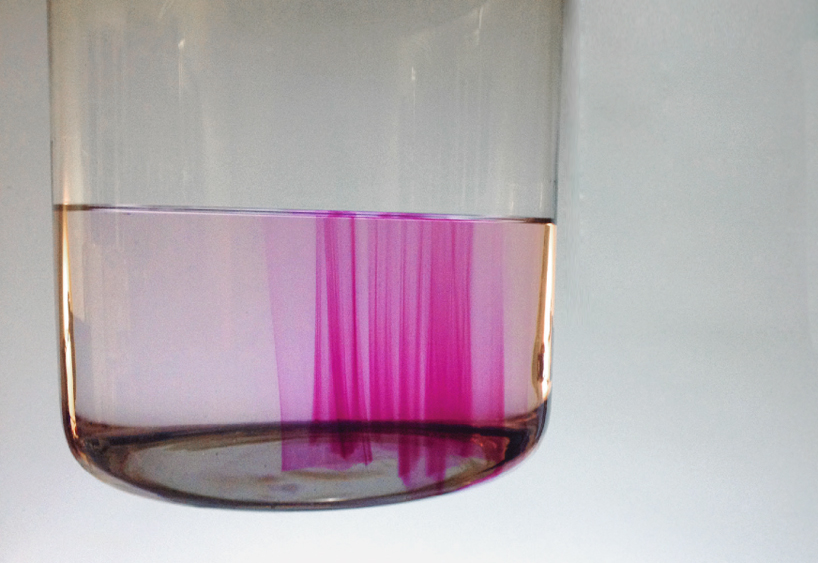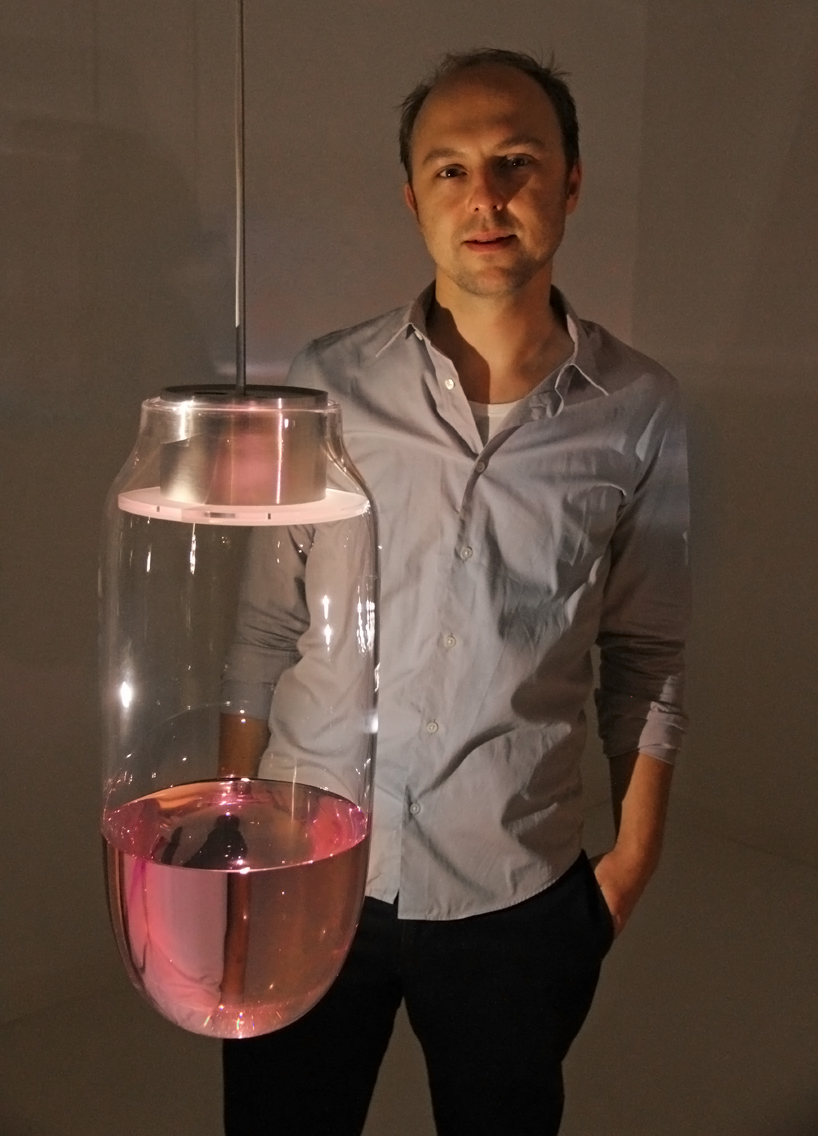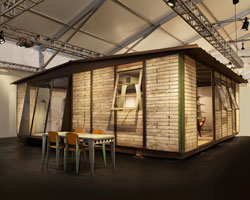phare no. 1–9, the new lightwork commissioned by perrier-jouët, was unveiled at design miami 2013
image © charles emerson
perrier-jouët presents phare nº 1 – 9 by simon heijdens at design miami 2013.
in celebration of art infusing beauty into everyday life, french boutique champagne producer perrier-jouët invited dutch designer simon heijdens to create a new work. heijdens’ immersive piece creates a captivating experience that reveals the poetry of the natural world through an avant-garde narrative. heijdens’ work blends art, craft, design and new techniques seamlessly, resulting in an exciting re-interpretation of what art nouveau means to the 21st century.

simon heijdens, phare no.1-9
image © charles emerson
the phare no. 1–9 installation is made of nine hand-blown glass vessels, part filled with transparent liquid, suspended in a pure white room. light emanates from each ‘phare’, referencing its namesake: a lighthouse.
we tried to understand how he managed to create such amazing effects. being a publication for ‘makers’ in the field of art, design and architecture, in our interview with simon, designboom investigated on photo-electrophoretic phenomena. they have been employed in scientific color-imaging systems, where light-sensitive pigment particles dispersed in highly insulating liquids are subjected simultaneously to strong electric fields and electromagnetic radiant energy. we were wondering if the selective migration of the particles produces the color image…
nine hand-blown glass vessels that draw a story using an entirely new, self-developed technology that makes drawings appear mid-water. using the dimensional qualities of water, and how it refracts light, the phares become lenses that project the appearing and dissolving drawings into the white surroundings. water is a narrative surface which, through its softness, reveals the patterns of wind that is passing over it. the pattern ripples from one phare through to the next, creating a drawing that exists in the space as a whole. the liquid is a particulate, light-sensitive compound (a pigment-dispersed composition) which under the influence of laser light results in a color change in the liquid in which the pigment is present, in this case — from transparent to magenta. the laser flashes on and off (as a series of pulses), and as it does so, the beam is reflected across the liquid receiving medium. a row of ‘dots is ‘painted on the surface. when the laser is on it creates a dot, the fine lines of the image are built up dot by dot.
in a reflection of perrier-jouët’s own material essence the work explores water as a dimensional volume, and it becomes a translucent refracting medium for light. a constantly evolving story grows within the water and is illuminated to fully immerse the space in pattern that moves from one phare to the next. the totally white environment thus becomes both a screen and a narrative that one can walk inside, allowing the experience of the piece from different perspectives.

visitors walking in the installation and are surprised by the light effect in flux, in a way similar to seeing a polaroid develop…
image © charles emerson
visitors walk around the vessels and can see the light drawings from different angles. the patterns that are projected on the floor continously change. the round bottom of the glass containers filled with water gives a lens effect and projects the drawing into the space.
from phare to phare
with phare no. 1–9 heijdens has found a completely new way of drawing and building up images. just as art nouveau saw jules chéret introduce the printed poster, and louis lumière create moving pictures, heijdens presents a new medium of expression that echoes the period’s temperament of aesthetic innovation. his work explores the concept of coincidence, to trace and reveal the hidden essence of the spaces and objects that surround us in everyday life. phare no. 1–9 delves to the core of art nouveau and its principles of a studio-based, crafted art-piece, and merges the organic with avant-garde technology. the installation breaks boundaries of how we experience the natural world, and opens up the static character of our structured surroundings.

the pigments are minute spheres, finely and uniformly dispersed in the liquid, in which a reaction takes place after irradiation with a laser beam
image © charles emerson
phare no. 1—9 looks at the surface of a body of water, how its sensitivity gives it a narrative quality that speaks directly and immediately about the surrounding conditions. the interplay of the sun on the surface, or the wind contuously changing its appearance and nature. phare no. 1—9 explores how the wind affects water, creating ripples, and their continuous movement across the surface. an entirely new way of drawing is created, performed inside the phares, which interprets the movement of the wind. merging the organic with avant-garde technology, the installation breaks boundaries of how we experience the natural world, and opens up the static character of our structured surroundings. water as the liquid is the material essence of perrier-jouet.

the wind and the movement trigger the three-dimensional drawings in the vessel
image © simon heijdens
the laser light takes its data from outdoor sensors which monitor the wind. this data is then transformed it into a beam of light that creates high-contrast and pin-sharp markings on the surface of the liquid. after a short moment, the drawing gradually dissipates and the liquid becomes transparent again.
‘I am interested in how we relate to the spaces and objects that surround us in everyday life, and the localities of a space. in the current tendency towards globalism, the spaces in which we live are increasingly perpetual and homogenous. their surface characterizes itself by a static hardness that only serves the one multilingual word that it was given. compared to a sandpath, for example — that through its softness informs on the variable conditions of its location, its climate, its inhabitants and use — there is a loss. when uncontrollable processes are eliminated from our daily surrounding, the natural timeline, and our connection and coincidental interaction with the space and objects around us. the intent is to reclaim these values. the static surface is made tactile to become evolutionary and legible again, to make the built environment around us reveal the character of its place and use.’ — simon heijdens

magenta fluid inside the volume
image © charles emerson
simon heijdens, phare no.1-9
video commissioned by perrier-jouët for crane TV
video © crane TV

looking inside the vial, laser-sensitive pigments are used for the production of an image in a transparent liquid
image © designboom

simon heijdens
image © designboom
simon heijdens
was born in 1978 in breda, the netherlands. his works merge the narrative and the tangible, and use the concept of coincidence to trace and reveal the hidden essence of the spaces and objects that surround us in everyday life. he studied experimental film at the university of berlin and conceptual design at design academy eindhoven (cum laude, 2002). founded in rotterdam in 2002, the practice is now based in london. projection works such as tree and lightweeds (site-responsive light projection, 2004) have been exhibited and installed in over 50 museums, galleries and public spaces throughout the us, europe, the middle east and asia. heijdens’ works are represented in the permanent collections of MoMA new york, boijmans van beuningen museum rotterdam, the art institute of chicago, the fonds national d’art contemporain france and the israel museum jerusalem; and have been exhibited extensively across the world including in the following museums: V&A london, stedelijk museum amsterdam, CCC moscow and CAFA beijing. other commissions and collaborations include swarovski crystal palace, droog, wallpaper handmade and gallery libby sellers london.
perrier-jouët serves its exclusive prestige belle époque cuvée champagne within the design miami/ collectors lounge and select vip events during the week of the fair
image © designboom
perrier-jouët
perrier-jouët is an iconic champagne house with an exceptional vineyard. it is known for the finesse, floral and elegant notes of its wines, fashioned with the expertise of only seven cellar masters since its foundation in 1811. since its very first artistic collaboration in 1902 with renowned french art nouveau artist emile gallé, who created the anemone design of its iconic belle epoque prestige cuvee, the house has continued to commission a roster of established and emerging designers and artists including daniel arsham, noé duchaufour- lawrance and most recently with glithero. see the designboom report here.
2013 marks the second successive year that perrier-jouët has taken part in design miami/, both through commissioning original work, and as the exclusive champagne partner for the fair. the role as a patron for contemporary design began in 1902, when the champagne house worked with the significant french art nouveau artist emile gallé. he created the iconic anemone of its belle époque cuvée, still used today. since then the house has commissioned many established and emerging designers as part of its continued artistic heritage.
art nouveau 1890 — 1914
this movement of visual arts was popular across europe during a time of great cultural and technological change. analysing the visual language of art nouveau one discovers a strong geometry of vector-based images. technological developments in lithographic printing, as pioneered by jules chéret, allowed for these lavish expressions of the natural and organic world. such industrial and technological developments were not simply expanding the artist’s palette. they had a profound, defining influence on the aesthetic and style of art, design and architecture of the period, much the same as the digital has in our time. both the popularisation of the printed poster through chéret, and the invention of cinema by lumiere, are clear markers for the sea change in society’s concept of media, that even today are still very apparent. in 1902 the renowned french artist who worked in glass, emile gallé created the signature anemone design for the belle époque bottle for perrier-jouët, capturing the spirit of the champagne. the principles of art nouveau have since formed the core of what perrier-jouët is about: celebrating beauty, craftsmanship and infusing art into everyday life.


























